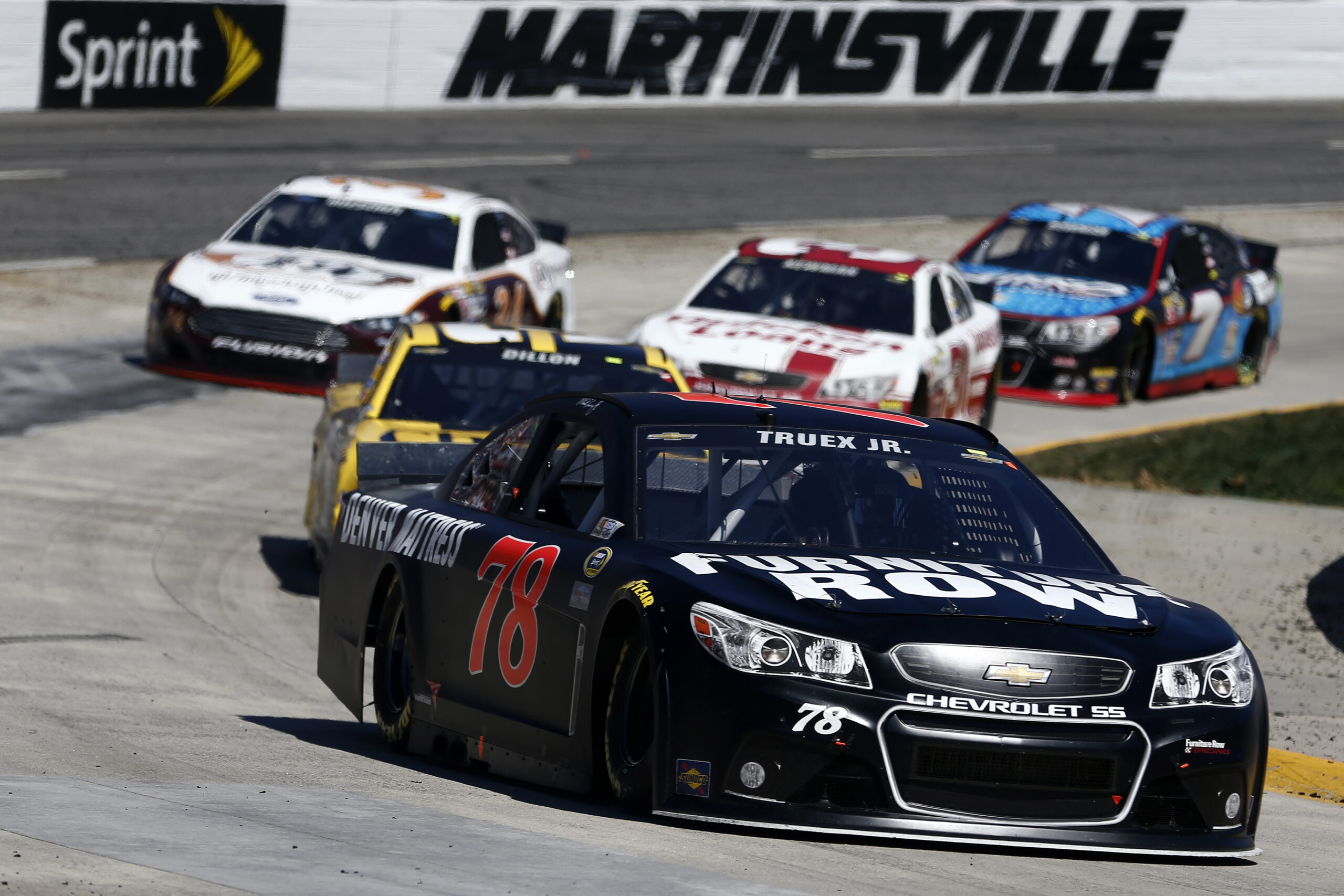MARTINSVILLE, Va.– NASCAR is back from the left coast and ready to go bumping and banging at the Virginia paperclip.
This week, the NASCAR Sprint Cup Series comes off the Easter holiday and rolls into Ridgeway, Virginia to run the STP 500 at Martinsville Speedway. The 500 lap race on the .526 mile (.847 km) short track will be the sixth race of the 2016 season.
After spending the previous month on the western end of the United States, Martinsville is the first stop of what I like to call the short track gauntlet. Over the course of April, the Sprint Cup Series will also visit Bristol Motor Speedway and Richmond International Raceway with Texas Motor Speedway sandwiched between Martinsville and Bristol.
Opened in 1947, Martinsville Speedway is the last remaining track from the NASCAR’s first season in 1948. It’s a throwback to a bygone era when race tracks were located in the middle of nowhere in the most remote parts of America. During that stretch of 68 years, many tracks have come and many more have gone. The only two constants in NASCAR are change and Martinsville. In a way, Martinsville serves as a bridge that connects the past to the present.
When people say Martinsville never changes, they’re right to a very large degree. Nine-time Martinsville winner Jeff Gordon once said that of all the tracks he’s raced at in his entire 23-year Sprint Cup Series career, Martinsville was the one track that changed the least. He said the way you drove the track in 1993 was virtually the same as the way he drove the track in his last start at the Virginia paperclip in 2015.

Martinsville is a rhythm-heavy race track. Once you figure out the rhythm, you can conquer all who race on it. You run against the wall on the straights and hug the yellow curb in the turns. Protecting the inside line is vital at Martinsville. You pass someone by diving underneath them going into turn 1 or turn 3 or you use your chrome bumper to gently nudge them out of the way. If you’re caught on the outside line, you’d better fall behind another car and get to the bottom or you’ll drift towards the back.
While you could run a 500 lap event on just three or four pit stops with a fuel window of 130 laps, you’ll be stopping for tires at least double-digit times. If you’re the race leader when the caution flies and forces overtime, you’re pretty much a sitting duck. If you pit, everybody behind you stays out. If you stay out, everybody behind you pits. To put it shortly, you have to pick your poison.

Like most short tracks, the tight confines and low banking means passing is at a premium at Martinsville. As I mentioned earlier, there are two primary ways to pass someone at Martinsville; dive underneath someone going into turn 1 and/or turn 3 or use the chrome bumper to nudge someone out of the way.
Many times in a race, one driver will nudge another out of the way, collect another driver and cause a multi-car pileup. Other times, one car will dive too deep into turns 1 or 3, hop the curb, slam into another car and cause a chain-reaction crash that way. This type of accordion-effect wrecking will happen multiple times in a 500 lap race at Martinsville.

With all the bumping and banging, it’s very easy to lose your composure. Keeping your temper in check is important to success at Martinsville.
Most of the time, it leads to a lead lap car forcibly nudging a lapped car out of his or her way. Sometimes, it can give us classic Martinsville moments like Brad Keselowski rubbing up against Kurt Busch for about five laps.
Other times, though, it can lead one driver who’s running nine laps down losing focus of reality, intentionally taking the race leader and getting that driver parked for two races.
I believe we’re going to see our first real test of the updated NASCAR behavioral policy this weekend in Martinsville. While I doubt we’ll see a repeat of what happened last November, I don’t think we’ve seen the last of drivers taking out one another at Martinsville.
Now let’s talk about drivers to watch this weekend.

The odds-on favorite at 9/2 is Jimmie Kenneth Johnson (Vegas Insider).
In his 28 career starts at Martinsville, the driver of the No. 48 Hendrick Motorsports Chevrolet has eight wins, 18 top fives (64.29 percent) and 22 top-10s (78.57 percent). He’s led nearly 3,000 laps (2746) and has a 7.5 average finish.
However, he hasn’t led a single lap at the Virginia paperclip since 2014 and has finished second, 32nd, 35th and 12th. That’s a 20.3 finishing average in the last four races.
I don’t see this trend continuing for a few reasons. First, the 48 team is on a roll right now having won 40 percent of the races so far this season. Second, Johnson is historically no slouch when it comes to Martinsville. Finally, his mentor was Jeff Gordon who made Martinsville his playground through his 23-year career.
I expect Johnson to be up front and contending for the win on Sunday.

Next, at 6/1 is James Dennis Alan “Denny” Hamlin.
In 20 career starts at Martinsville, the driver of the No. 11 Joe Gibbs Racing Toyota has five wins, 11 top fives (55 percent) and 16 top-10s (80 percent). He’s led over 1,000 laps (1315) and has an average finish of eighth.
Unlike Johnson, the last four races have been kind to the Virginia native with finishes of 19th, eighth, first and third. That’s a 7.8 finishing average.
He’s also the defending race winner having led 91 laps on his way to scoring his first checkered flag of the 2015 season. He enters Martinsville with a win in the Daytona 500 and three top-10s. He’s finished on the podium in the last two races and looks to continue that run this weekend.
I expect Hamlin to contend for the win on Sunday.

Next, at 6/1 is one Joseph Thomas Logano.
Since 2014, the driver of the No. 22 Team Penske Ford has been arguably the best at the Virginia paperclip with finishes of fourth, fifth, third and 37th. In those four races, he led 39, 60, 108 and 207 laps.
In the last visit to Martinsville, he and teammate Brad Keselowski had the field in check the entire afternoon before Keselowski suffered a suspension failure and crashed out of the race. Logano was in total control with 47 laps remaining, but then he was eliminated from the race after being intentionally wrecked by Matt Kenseth.
Both drivers are smart enough to know that it wouldn’t be in the best interest of either of them to re-light that fire and force NASCAR to step in again, so I don’t expect anything to come about from it this time around.
I see no reason as to why he won’t be a force on Sunday.

The final driver to keep your eye on this weekend at 7/1 is Kevin Michael Harvick.
In 29 career starts at Martinsville, the driver of the No. 4 Stewart-Haas Racing Chevrolet has amassed one win, three top fives (10.35 percent) and 14 top-10s (48.28 percent).
That might not seem like much, especially compared to the success of Johnson, but in his last four starts, he’s finished seventh, 33rd, eighth and eighth. That’s an average finish of 14th. In the last two trips to the Virginia paperclip, he’s led 154 and 38 laps.
At any other track, Harvick would be my outright pick to win. I’m not as willing to go out on that limb at Martinsville. He’s only finished in the top-five three times and those were during his time at Richard Childress Racing. While I do expect him to be leading at some point Sunday, I wouldn’t pick him over someone like Johnson to win.
Tune into the STP 500 on Sunday to see who takes home the grandfather clock. You can watch the race beginning at 12:30 p.m. on FOX Sports 1 or at noon on the Motor Racing Network and Sirius XM (subscription required for the latter). If you’re within a few hours of Ridgeway, Virginia, hop in your car, drive to the track and watch the action in person. I’m on assignment at Martinsville this weekend, so I’ll be bringing you all the happenings from the media center.







